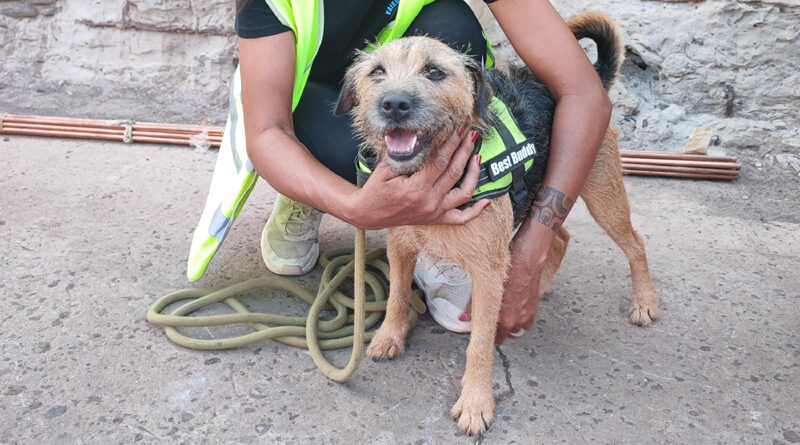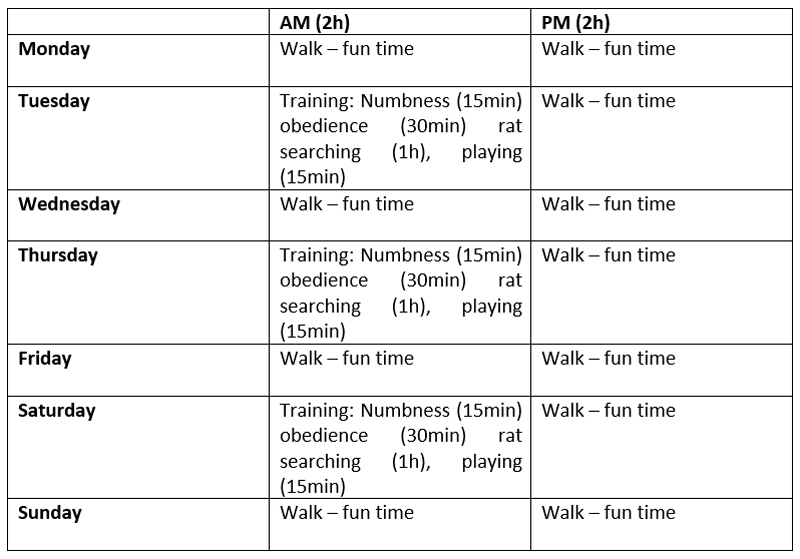Q&A: MEET TIP THE DOG FROM THE MARQUESAS ISLAND OF UA HUKA
Chloé Brown is Director of the Association Vaiku’a i te manu o Ua Huka – a conservation organisation on the remote island of Ua Huka in the Marquesas archipelago in French Polynesia. The island is home to two critically endangered birds and these birds are protected, indirectly by Tip, who has a nose for finding predators…
Chloé, please introduce us to Tip.
Tip (female) is a border terrier rat detector, imported from New Zealand. She arrived in July 2021 although we should have got her in 2020. When COVID-19 hit, her arrival had to be canceled. Because of this delay, we got her older than expected, at the age of 2.5 years instead of 1.5 years old. Some may wonder why we get our dogs from New Zealand (NZ), knowing that the country was locked down for about two years. The answer is that the trainer who provide them to us is one of the best for rat detecting dog, in the entire Pacific. So, dealing with him is a guarantee for us that our dogs will be operational. Also getting a dog from NZ is way cheaper than getting one from USA or Europe.
Who looks after Tip?
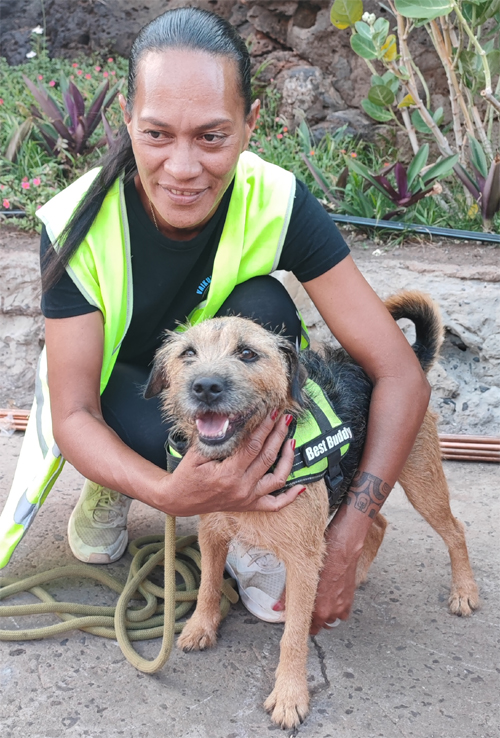 Tip lives 24/7 with her handler Sabrina. Sabrina was recruited at the end of 2021 after two months training with an expert trainer from Tahiti. Then, when the first handler left us, she took on Tip from the beginning of 2022. Sabrina, is native from Ua Huka, she was born and raised on this island. She’s passionate about her land and culture, and she was a great athlete in her early years. At first she didn’t want this job, because, she said she “didn’t like dogs”, but step by step, seeing the work with the trainer we sent from Tahiti, she got more and more interested. When she got to work with Tip, she fell in love with her.
Tip lives 24/7 with her handler Sabrina. Sabrina was recruited at the end of 2021 after two months training with an expert trainer from Tahiti. Then, when the first handler left us, she took on Tip from the beginning of 2022. Sabrina, is native from Ua Huka, she was born and raised on this island. She’s passionate about her land and culture, and she was a great athlete in her early years. At first she didn’t want this job, because, she said she “didn’t like dogs”, but step by step, seeing the work with the trainer we sent from Tahiti, she got more and more interested. When she got to work with Tip, she fell in love with her.
Nowadays they both are inseparable. Their schedule is already planned, they have three to four training sessions per week and go on hikes around the island or have fun at the beach. Sabrina takes her everywhere she goes. Tip lives with Sabrina and has become part of her family. There have been times when Sabrina has had to leave the island for a few days, so her husband and daughter keep Tip with them, taking her on walks etc.
Why does Ua Huka need Tip?
Ua Huka is one of the last two islands in French Polynesia, that doesn’t have the black rat (rattus rattus). The black rat is the main threat for the avian fauna and agriculture. Ua Huka is home to two endemic protected birds, the “Ultramarine lorikeet” and the “Iphis monarch”, both listed as “critically endangered” on the IUCN red list. This is mainly because both only live on Ua Huka and cannot be found anywhere else in the world.
It has been proven that the ultramarine lorikeet, who originally lived in four of the Marquesan archipelagos, went extinct when wharfs, that allowed cargo ship to dock directly onto the island, were built. Thus, when cargos docked on the wharfs, it was easy for the black rats to get on the islands. These rats then ate the birds’ eggs, leading to their extinction.
So, getting Tip is the main way we keep the black rat out of our island, not only to save our endemic birds but also to keep our economy safe. Indeed, the exportation of copra (from coconuts) is the principal resource of the island, as 80% of the inhabitants live off the money they get from exporting it. Previous studies showed the introduction of the black rat on Ua Huka would represent an economic loss of 50% to 70%.
What is an average day like for Tip?
This is a typical week for Tip when there’s no cargos on Ua Huka.
There’s no training on cargo days, also the day before and after a cargo day. During training we use cooked chicken breast or her favorite ball as a reward when she indicates or find rats. Also, to keep her motivated, we use covered dead Polynesian rat or better still, live rat captured by our local biosecurity team.
On cargo days Tip and Sabrina wait at the dock and Tip is ready to sniff out any black rats that may try to enter the island. This is Tip’s most important job – spotting and catching any black rats before they make it on to the island, where finding them would be much more difficult.
What difference has Tip (and her retired predecessor) made to conservation and the bird populations of Ua Huka?
These endangered birds, and our agriculture, has survived for thousands of years without the black rat, so this is a preventative measure. You could say, nothing has changed as a result of Tip’s presence – and that is exactly what we want! However, it has had a noticeable impact on the local population of the other Marquesas islands as they realize that we have to preserve our nature and our endemic species if we don’t want them to go extinct. The “Pihiti” or ultramarine lorikeet is our pride and the emblem of our community. Also, step by step, more and more people on our island and elsewhere are understanding that preserving these birds helps preserve the copra and therefore the economy of the island.
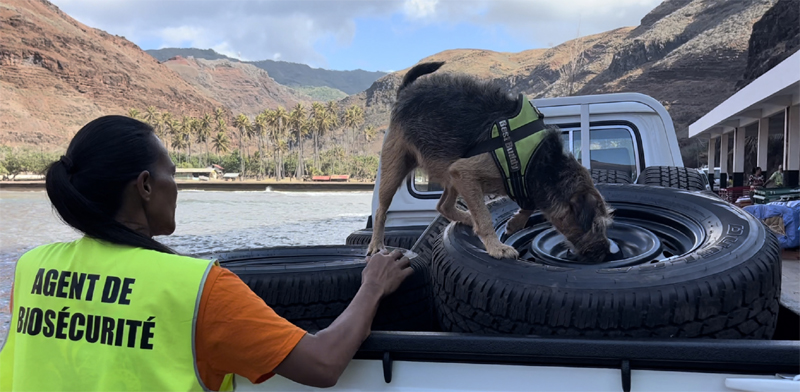
Why don’t any of the other islands in the Marquesas have a dog like Tip?
Every other island has the black rat. Actually, all of the French Polynesian islands have it, except Ua Huka and Rimatara (Australes archipelago). These rodents were imported by the Europeans during colonization. The remoteness of Ua Huka and Rimatara is one of the reasons why their biodiversity is still so well conserved.
What else are you doing to protect and increase the bird populations on Ua Huka?
We take actions on a lot of different levels:
- Twice a month, the biosecurity team, sets rat traps all around the island to make sure no black rats are on the island. Also, 24 rat poison stations are placed on every entry point of the island (Vaipaee’s wharf, Hane’s beach and at the airport).
- We also study the impact of feral cats on our bird populations.
- We participate, with the “SOP MANU” (Polynesian Ornithological Society), counting birds on the island.
- We prevent the introduction of other EEE (exotic invasives species) as: invasives plants (Miconia), birds (Bulbul, Martin triste) or fire ants etc. threaten the lives of our endemic birds.
- We prevent the expansion of invasives trees that are already on the island, to protect the habitat of the native birds. This action is undertaken by volunteers.
- In 2022, we started a project planting indigenous trees on a part of the island that burnt in 2021. We knew that lots of birds lived on that side and consequently, nests and surely live birds, perished in the flames. On the 30 hectares that burned, we are planting at least 2500 plants on four hectares, with funds from the “Office Français de la biodiversité”.
- We have set up public awareness workshops on Ua Huka and, our scholar workshops on other Marquesan islands.
I understand you are hoping to get a second dog like Tip, why is that?
We need a second dog to work with Tip for two major reasons:
- Tip is already working too much, she’s supposed to work up to three hours maximum. But the cargos take five to eight hours per day to unload. Therefore, she can’t have breaks and is exhausted. Because of that, the biosecurity is less efficient. With a second dog, they could swap around so that it keeps the work efficient.
- The Municipality is planning to build a wharf on Hane’s bay. The debut is planned for this year and the inauguration is planned for 2024, therefore we will have to work on two wharfs and sometimes at the same time, for example when the Aranui 5 and Taporo come the same day. We will therefore need a second dog and we’ll need to recruit and train two more people: one handler and one biosecurity agent.
This second dog is already on his way. He has been trained in New Zealand and we hope he will arrive in April 2023. We chose him last year and he has been trained since then. His name is “Tuki” – meaning “to hit”. Funds to buy Tuki came 50% from “Initiative Kiwa” and 50% from the Polynesian Direction of Environment “DIREN”. The salaries and other charges linked to the biosecurity work is partly funded by the “Initiative Kiwa” and partly by Association Vaiku’a.
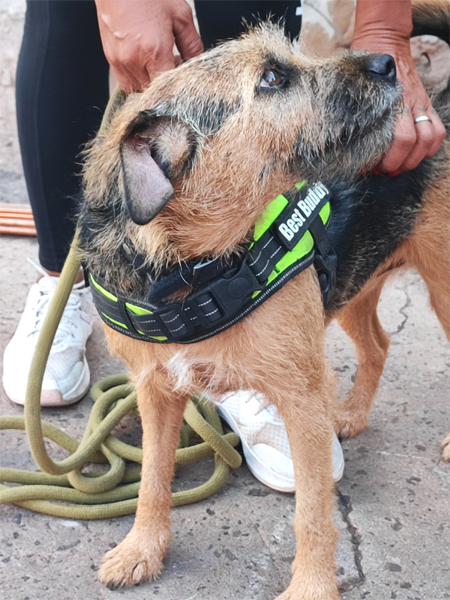 And for the future?
And for the future?
We are planning to carry out an in-depth study on the “blue lorikeet” and the “Iphis monarch” to study their behaviour, way of life, and the stages of reproduction, etc.
I’d also like to have more impact on children by creating educational support such as books, films etc. to increase their knowledge of the birds and the role they play in the local ecosystem.
In addition, we are looking at ways to prevent herbivores, such as goats and horses, from straying into protected areas. They can harm the natural regrowth of trees and increase the negative effects of drought and soil erosion.
And we will be continuing our reforestation program all over the island to create more habitat for the birds and give Ua Huka back its real colours.
But most important of all, we want to ensure that the black rat will never get on to Ua Huka.
We hope that with the biosecurity work and the reforestation work we are doing we’ll be able to create a better place, not only for birds but also for people, to live in harmony. Hopefully over the coming years, more people will realize our duty to keep our nature healthy for our own health. And we hope our children will carry on the good work that has been started so that next generations will be lucky enough to witness the land we always knew: safe and preserved.
Where can we find out more in UK?
You can follow us on our Facebook page: facebook.com/associationvaikua
Or on our Instagram page: @association_vaikua
We also have a website: protectuahuka.pf (currently being updated).

